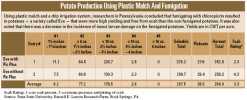The Fumigation Factor

The production of potatoes using plastic mulch, drip irrigation, and row covers has been proven effective for small acreage growers throughout areas of the Northeast. It is traditional in this area of the country in the late spring and early summer for consumers to anticipate the arrival of “new potatoes” or “B” size red potatoes at local retail stands.
Research on the use of plastic mulches and drip irrigation for the production of potatoes has been investigated for more than 30 years. It wasn’t until the introduction of some of the newer colored plastic mulches (red, metallized, silver, and blue) and drip irrigation tapes and row cover materials that the use of these technologies for the production of some of the new potato varieties was again researched.
The potato in question is Eva, a round white potato with a bright white skin and flesh color, shallow eyes, good eating and storage qualities that has one significant drawback: susceptibility to common scab. Common scab ruins the bright white skin of Eva and, in a marketplace where appearance is important, that makes Eva difficult to promote.
Recent research on the use of chloropicrin to control common scab on conventionally grown potatoes has been undertaken in Wisconsin and Florida. The object of the research was to investigate the effect the fumigant added to the plasticulture system would have on the incidence of common scab on Eva.
Fertilizer And Fumigant
Conducted in Rock Springs, PA, the experiment was done on silty clay loam soil. Fertilizer was broadcast on fields just prior to forming beds, and applying the black plastic mulch and drip irrigation tape, and fumigating with Pic Plus (chloropicrin, Hendrix and Dail, Inc.) About two weeks later, B size potato seed pieces of Eva were planted in double rows spaced at 30 centimeters (cm) apart and 30 cm in the row and 7.6 cm deep using a waterwheel transplanter. Row middles were treated with herbicides.
Drip irrigation was applied during the growing seasons to maintain sufficient moisture in the beds. A standard control program for insect and diseases was followed. The vines were killed on Aug. 24, using Reglone (diquat dibromide, Syngenta Crop Protection), and the potatoes were harvested on Sept. 4, weighed, graded according to size and culls, and rated for the amount and severity of scab present on the potatoes.
Experiment Results
Visual observation showed that the height of all potato rows receiving fumigation compared to those not receiving fumigation. The double rows of the fumigated potatoes filled in much quicker than the non-fumigated rows. At harvest, it was visually apparent that the fumigated potatoes were definitely more high yielding and free from scab than the non-fumigated potatoes.
In addition, there was a decrease in the incidence of insect larvae damage (wireworms or flea beetle) on the potatoes that were fumigated. This was indeed confirmed when the potatoes were washed and graded (see chart).
It should also be noted that some of the potatoes were not planted as deep as they should have been, due to the dry condition of some of the plastic covered beds and this resulted in a higher number of rotted potatoes.









